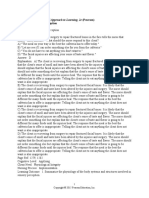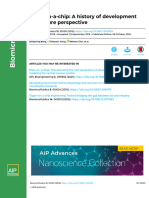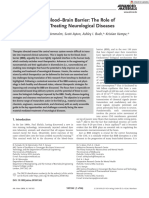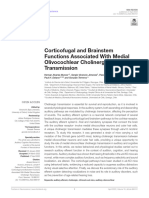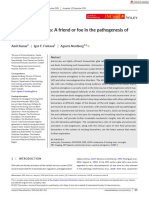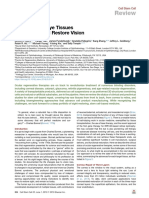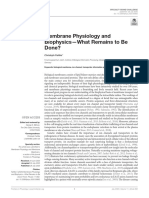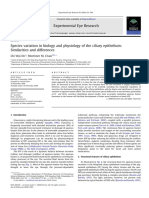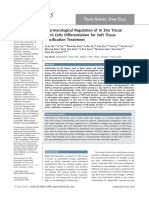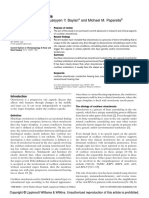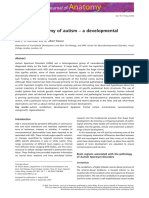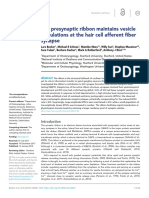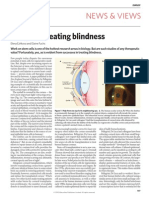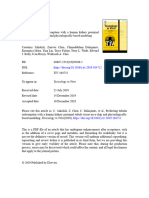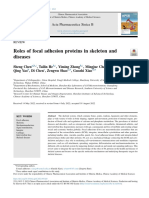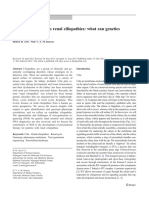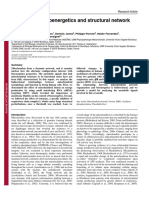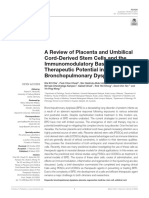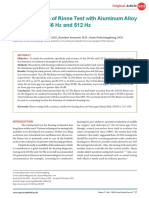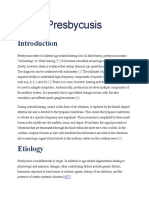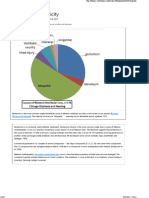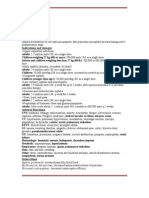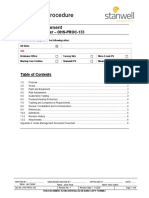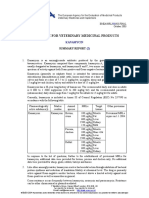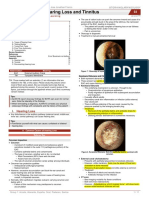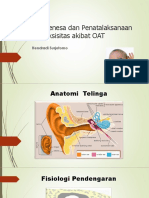Prayuenyong 2021 Kokleotksik
Prayuenyong 2021 Kokleotksik
Uploaded by
Fitria WaffiCopyright:
Available Formats
Prayuenyong 2021 Kokleotksik
Prayuenyong 2021 Kokleotksik
Uploaded by
Fitria WaffiOriginal Title
Copyright
Available Formats
Share this document
Did you find this document useful?
Is this content inappropriate?
Copyright:
Available Formats
Prayuenyong 2021 Kokleotksik
Prayuenyong 2021 Kokleotksik
Uploaded by
Fitria WaffiCopyright:
Available Formats
REVIEW
published: 26 July 2021
doi: 10.3389/fnins.2021.695268
Preferential Cochleotoxicity of
Cisplatin
Pattarawadee Prayuenyong 1,2† , David M. Baguley 2,3,4* † , Corné J. Kros 5† and
Peter S. Steyger 6†
1
Department of Otorhinolaryngology, Head and Neck Surgery, Faculty of Medicine, Prince of Songkla University, Songkhla,
Thailand, 2 Hearing Sciences, Division of Clinical Neurosciences, School of Medicine, University of Nottingham, Nottingham,
United Kingdom, 3 National Institute for Health Research (NIHR) Nottingham Biomedical Research Centre, Nottingham,
United Kingdom, 4 Nottingham Audiology Services, Nottingham University Hospitals NHS Trust, Nottingham,
United Kingdom, 5 School of Life Sciences, University of Sussex, Brighton, United Kingdom, 6 Translational Hearing Center,
Biomedical Sciences, Creighton University, Omaha, NE, United States
Edited by:
Gwenaelle S. G. Geleoc,
Boston Children’s Hospital Cisplatin-induced ototoxicity in humans is more predominant in the cochlea than in the
and Harvard Medical School, vestibule. Neither definite nor substantial vestibular dysfunction after cisplatin treatment
United States
has been consistently reported in the current literature. Inner ear hair cells seem to
Reviewed by:
Hernan Lopez-Schier,
have intrinsic characteristics that make them susceptible to direct exposure to cisplatin.
Helmholtz Zentrum München, The existing literature suggests, however, that cisplatin might have different patterns
Helmholtz-Gemeinschaft Deutscher
of drug trafficking across the blood-labyrinth-barrier, or different degrees of cisplatin
Forschungszentren (HZ), Germany
Suhrud Rajguru, uptake to the hair cells in the cochlear and vestibular compartments. This review
University of Miami, United States proposes an explanation for the preferential cochleotoxicity of cisplatin based on current
*Correspondence: evidence as well as the anatomy and physiology of the inner ear. The endocochlear
David M. Baguley
David.baguley@nottingham.ac.uk
potential, generated by the stria vascularis, acting as the driving force for hair cell
† ORCID: mechanoelectrical transduction might also augment cisplatin entry into cochlear hair
Pattarawadee Prayuenyong cells. Better understanding of the stria vascularis might shed new light on cochleotoxic
orcid.org/0000-0002-3002-0497
mechanisms and inform the development of otoprotective interventions to moderate
David M. Baguley
orcid.org/0000-0002-0767-0723 cisplatin associated ototoxicity.
Corné J. Kros
orcid.org/0000-0003-1429-4145 Keywords: cisplatin, ototoxicity, cochlea, vestibular, cochleotoxicity, vestibulotoxicity
Peter S. Steyger
orcid.org/0000-0002-6103-5237
INTRODUCTION
Specialty section:
This article was submitted to Cisplatin (platinum-based chemotherapy), is the mainstay treatment for curative care of various
Perception Science, cancers (Makovec, 2019). Ototoxicity is a common side effect of cisplatin which can limit its
a section of the journal usage and dosage (Qi et al., 2019). Ototoxicity refers to drug-induced damage affecting the inner
Frontiers in Neuroscience
ear structures and related neural tissues, causing cochlear dysfunction (such as hearing loss or
Received: 14 April 2021 tinnitus) and/or vestibular dysfunction (such as vertigo, dizziness, or imbalance) or both (Lanvers-
Accepted: 06 July 2021
Kaminsky et al., 2017). The damage can manifest in cellular degeneration and/or functional
Published: 26 July 2021
impairment. Unlike other side effects of cisplatin (such as nephrotoxicity), ototoxicity can cause
Citation: irreversible injury to the inner ear as human inner ear sensory hair cells generally cannot
Prayuenyong P, Baguley DM,
regenerate (Rubel et al., 2013). Furthermore, no known effective protective or curative strategies
Kros CJ and Steyger PS (2021)
Preferential Cochleotoxicity
are presently available for cisplatin-induced ototoxicity although clinical trial data is emerging
of Cisplatin. (Mukherjea et al., 2020).
Front. Neurosci. 15:695268. This review gleans the current evidence of cisplatin-induced ototoxicity and the mechanisms
doi: 10.3389/fnins.2021.695268 in the light of existing literature and data. Possible mechanisms are suggested as to why
Frontiers in Neuroscience | www.frontiersin.org 1 July 2021 | Volume 15 | Article 695268
Prayuenyong et al. Preferential Cochleotoxicity of Cisplatin
cisplatin predominantly affects the cochlea while relatively homeostasis in maintaining the high K+ concentration (Takeuchi
sparing the vestibular counterpart based on available preclinical et al., 2000; Ciuman, 2009). Despite the morphological and
and clinical data. functional similarities of both cells, the marginal cells are part
of the multi-layered stria vascularis, while the vestibular dark
cells form a single-layered epithelium (Ciuman, 2009). The
SIMILARITIES AND DIFFERENCES OF complex structure of the stria vascularis at the lateral wall of
COCHLEAR AND VESTIBULAR ORGANS the endolymphatic space of the cochlea - consisting of marginal,
intermediate and basal cell layers—seems to underlie the high
The cochlear (responsible for hearing) and vestibular endocochlear potential. Intermediate cells and basal cells of the
(responsible for balance) parts of the inner ear have a very stria vascularis, and fibrocytes in the adjacent spiral ligament
close anatomical relationship, and share a common source are responsible for the generation of the endocochlear potential
of blood and fluid supplies (Flint et al., 2014). These two (Takeuchi et al., 2000; Marcus et al., 2002). On the other hand,
components have replete similarities in anatomy, cellular and there is no analogous structure in the vestibular organ. Cochlear
molecular components. The perilymph and endolymph of both and vestibular structures and supporting cells are illustrated in
structures have similar electrolyte compositions—the perilymph Figure 1.
containing low potassium (K+ ) and high sodium (Na+ )
concentrations, and the endolymph containing high K+ and low
Na+ concentrations. Specific cells and structures are required to PRECLINICAL DATA OF CISPLATIN
maintain the electrolyte concentrations and homeostasis of the OTOTOXICITY
inner ear fluid (Koppl et al., 2018). Active transport mechanisms
and essential structures for cation transport (e.g., Na+ /K+ - Cisplatin is a cell-cycle non-specific agent that can kill a cell
ATPase, Na+ -K+ -2Cl− cotransporter and mitochondria) are during any phase of the cell cycle, and so can act on both
needed to maintain a very high K+ concentration and recycling proliferating and non-proliferating cells (Mills et al., 2018). The
of electrolytes into endolymph (Wangemann, 1995; Ciuman, neutral cisplatin is activated when it enters human cells, in that
2009). Vestibular and cochlear sensory hair cells, responsible for one or both of the chloride ions can rapidly be substituted by
mechanosensation, are comparable in many respects including water (aquation) resulting in monovalent or divalent cations
shape, morphology and the arrangement of stereocilia at the (Makovec, 2019).
apical membrane. The cytotoxic effects of cisplatin may occur via at least two
However, a major physiological difference of both structures major mechanisms. One mechanism is the formation of DNA
is the endolymphatic potential. The endolymphatic potential (deoxyribonucleic acid) adducts, leading to DNA denaturation
is a K+ equilibrium diffusion potential, in the cochlea across which blocks cell division processes (Makovec, 2019). Another
the apical membranes of the intermediate cells in the stria mechanism of action involves the increased formation of reactive
vascularis (Wangemann, 2002). Considering the inner ear as an oxygen species and oxidative stress (Rybak et al., 2019). The
electrical field, the endolymphatic potential is the quantity that intracellular pathway remains unclear but it seems to be
determines the energy of charge. The endocochlear potential related to apoptosis (programmed cell death) and necroptosis
is as high as +80–100 mV (relative to perilymph) while the (programmed necrosis or inflammatory cell death) pathways
endovestibular potential is only up to + 10 mV. Mammals (Callejo et al., 2015; Ruhl et al., 2019). These mechanisms
have an extremely high endocochlear potential compared to ultimately lead to cell death via apoptosis (Mitra et al., 2017).
other animal species (Koppl et al., 2018). It is suggested that
positive extracellular potentials around the hair cells augment Preclinical Data of Cochleotoxicity
the electrical gradient that is the major driving force for K+ The suggested pathway of cisplatin trafficking from the
and Ca2+ (calcium) influx during sensory transduction and bloodstream into the cochlea is displayed in Figure 2. To
subsequently enhance the neurotransmission of sounds (Hibino cause ototoxic damage, cisplatin must first cross the blood-
and Kurachi, 2006; Koppl et al., 2018). In contrast, the vestibular labyrinth barrier, a specialized structure consisting of tight
compartment demands lower endolymphatic potentials for its junction-coupled inner ear endothelial cells, which separates
proper function, and equivalently has an endolymphatic potential the inner ear tissues from the blood stream. The small size of
of less than +10–15 mV among different species (fish, amphibia, the cisplatin molecule allows it to enter the inner ear via the
reptiles, birds, and mammals) (Koppl et al., 2018). Lee and blood-labyrinth barrier at the stria vascularis (Karasawa and
Jones (2018) demonstrated the functional discrepancy of both Steyger, 2015; Chu et al., 2016; Breglio et al., 2017). Cisplatin
compartments after the disruption of K+ concentration causing then enters the endolymph in the scala media, potentially
acute reductions in the endolymphatic potentials in mice. While via the organic cation transporter 2 (OCT2) and/or copper
the cochlear response was significantly reduced as it requires a transporter 1 (CTR1) in the marginal cells. Drug clearance
large transepithelial electrical potential for appropriate function, from the stria vascularis into the endolymph seems to be a
the vestibular response was unaffected as it is relatively insensitive major contributing factor for ototoxicity among platinum-based
to changes in the endolymphatic potentials. chemotherapy (Ding et al., 2012; Gersten et al., 2020). From the
The marginal cells of the cochlea, and the dark cells of endolymph, cisplatin can enter the cochlear hair cells via a variety
the vestibule are responsible for endolymph production and of cation transporters, via the mechanoelectrical transduction
Frontiers in Neuroscience | www.frontiersin.org 2 July 2021 | Volume 15 | Article 695268
Prayuenyong et al. Preferential Cochleotoxicity of Cisplatin
FIGURE 1 | Supporting cells and structures of the inner ear. (A) Schematic drawing of dark cells and transitional cells in the semicircular canal. (B) Schematic
drawing of stria vascularis within the cochlea illustrating the marginal, intermediate and basal cell layers. Figures are not drawn to scale.
channel pore, transmembrane channel-like protein 1 (TMC1), cochlear homeostasis. After cisplatin administration, cellular
or by passive diffusion at apical membranes (Pabla et al., 2009; degeneration was observed in outer hair cells of the organ of
Ding et al., 2012; Waissbluth and Daniel, 2013; Kros and Steyger, Corti, marginal cells of the stria vascularis, spiral ganglion cells,
2018). Furthermore, platinum is retained in the human cochlea and synaptopathy between inner hair cells and spiral ganglion
for many months to years after cisplatin treatment, while it is neurons (Brock et al., 2012; Chen et al., 2021).
eliminated over the following days to weeks in other organs Marginal cells of the stria vascularis could be the earliest
(Breglio et al., 2017). The hyper-deposition of cisplatin in the targets of cisplatin ototoxicity (Thomas et al., 2006). Damage of
human cochlea appears to be a unique important mechanism of the stria vascularis triggers functional alterations and apoptotic
progressive and delayed-onset cisplatin-induced cochleotoxicity. damage resulting in a reduced generation of the endocochlear
It is suggested that cochlear cells are susceptible to cisplatin potential and a disturbance in the electrolyte composition of
because of high drug uptake, high metabolic rate of these endolymph, both of which are required for optimal auditory
cells, and long-term retention of the drug (Schacht et al., 2012; function (Laurell et al., 2007). A temporary reduction and
Breglio et al., 2017). recovery of endocochlear potential after cisplatin administration
The mechanisms of cisplatin-induced cochlear dysfunction has been reported (Klis et al., 2002; Sluyter et al., 2003; Breglio
are associated with cellular damage as well as disruption of et al., 2017). This occurrence could be primarily responsible
Frontiers in Neuroscience | www.frontiersin.org 3 July 2021 | Volume 15 | Article 695268
Prayuenyong et al. Preferential Cochleotoxicity of Cisplatin
FIGURE 2 | Suggested pathways of cisplatin trafficking in the cochlea. The major entry route for cisplatin entry into the cochlea is via the blood-strial barrier into the
stria vascularis, and clearance into the endolymph from the stria vascularis prior to entry into hair cells across their apical membrane. Reproduced with modifications
from Kros and Steyger (2018) with permission of Cold Spring Harbor Laboratory Press. OCT2, Organic cation transporter; CTR1, Copper transporter 1; TMC1,
Transmembrane channel-like protein 1.
for very early short-term reversible hearing loss after cisplatin direct cisplatin exposure routes in these studies are not standard
exposure when a very slight degeneration of cochlear hair cells methods of cisplatin treatment in humans and so they lack the
was reported (Tsukasaki et al., 2000; Klis et al., 2002). Cochlear potential to evaluate physiological pharmacokinetics, especially
function then recovers in parallel with the restoration of the vascularity and blood-labyrinth barrier function.
endocochlear potential as long as the hair cells remain intact. Conversely, minimal or no impact upon vestibular hair cells
Cochlear outer hair cells showed the most prominent was reported after systemic cisplatin administration in guinea
damage after cisplatin treatment, suggesting that they are more pigs, whereas there was a substantial loss of cochlear outer hair
susceptible to injury and have a limited capacity for recovery cells within the same setting (Schweitzer et al., 1986; Laurell and
(Callejo et al., 2015). Permanent hair cell loss is thought to be Bagger-Sjoback, 1991; Sergi et al., 2003). A minor loss of hair
responsible for long-term irreversible hearing loss (Tsukasaki bundles after cisplatin exposure was also described (Nakayama
et al., 2000; Klis et al., 2002). Hair cell apoptosis could be caused et al., 1996; Ding et al., 1997). Overall, no study demonstrated
by either direct injury after cisplatin entrance, or an indirect effect extensive histological deterioration of vestibular organs after
related to the disruption of cochlear fluid homeostasis. systemic cisplatin exposure as in analogous cochlear studies.
In animal models, some functional vestibular loss has been
Preclinical Data of Vestibulotoxicity identified after cisplatin administration in semicircular canals
There are fewer reports in the literature about cisplatin (Sergi et al., 2003; Cheng et al., 2006; Takimoto et al., 2016),
vestibulotoxicity than about cochleotoxicity. After topical and otolith organs (Lo et al., 2015). The fact that morphological
cisplatin administration, degeneration of vestibular hair cells vestibular damage was not found at an early stage suggests
in utricular macula and cochlear outer hair cells was similar that functional vestibular impairment may not be associated
(Zhang et al., 2003; Cunningham and Brandon, 2006; Schmitt with sensory hair cell damage but other biochemical factors
et al., 2009). Likewise, a parallel degree of vestibular and cochlear that cannot be seen in histological results (e.g., electrolyte or
hair cells loss was reported after trans-tympanic cisplatin electropotential disturbance).
administration in the rat (Callejo et al., 2017). These results Currently, there is no study of cisplatin trafficking, uptake,
indicate that cisplatin, by local administration, seems to have a and disruption of intracellular physiological pathways in the
similar effect on hair cells of both compartments. However, the vestibular organs. It is possible that it involves the vestibular
Frontiers in Neuroscience | www.frontiersin.org 4 July 2021 | Volume 15 | Article 695268
Prayuenyong et al. Preferential Cochleotoxicity of Cisplatin
equivalent of the stria vascularis (dark cells and/or the (Halmagyi et al., 2017). This means that a positive finding of
transitional cells surrounding vestibular sensory epithelia, that abnormality on vHIT can strongly rule in vestibular disorder,
are responsible for endolymph production and homeostasis) but that a negative result may not be relied upon to exclude
which has been demonstrated for aminoglycoside antibiotics (Liu vestibular pathology. However, the vHIT assesses VOR function
et al., 2015; Kros and Steyger, 2018). in the high frequency where it is physiologically most relevant.
Additionally, benign paroxysmal positional vertigo (BPPV) was
relatively prevalent in this group of patients (9.2%). This figure is
CLINICAL DATA OF CISPLATIN higher than the life-time prevalence of BPPV (2%) (von Brevern
OTOTOXICITY et al., 2007), and vertigo (7%) (Neuhauser et al., 2005) in the adult
general population.
Clinical Data of Cochleotoxicity To date, there is no study of patients treated with cisplatin that
Hearing loss to variable degrees has been reported in 40– incorporates the caloric test, rotational chair test, and vHIT to
80% of patients treated with cisplatin depending on patient evaluate the VOR across different frequency ranges in the same
characteristics, drug dosage, and differences in tools and grading setting. In case of aminoglycoside ototoxicity, vestibular function
system (Landier et al., 2014; Frisina et al., 2016). The typical in low-mid frequency ranges was selectively affected but high
characteristics of cisplatin-induced hearing loss are irreversible, frequency function was spared (Walther, 2017). It is thus possible
bilateral symmetrical sensorineural hearing loss affecting higher that the caloric and rotational chair tests are more sensitive
frequencies initially, then followed by lower frequencies (Rybak tools to detect vestibular impairment after ototoxic medication
et al., 2019). Hearing loss often occurs in a dose-related and treatment (American Academy of Audiology, 2009).
cumulative fashion (Landier, 2016; Paken et al., 2016). Forty
percent of testicular cancer survivors who received cisplatin also
complained of tinnitus which was significantly correlated with PROPOSED HYPOTHESIS OF
reduced hearing (Frisina et al., 2016). Therefore, monitoring PREFERENTIAL COCHLEOTOXICITY OF
of cochleotoxic effects of cisplatin is advised and implemented CISPLATIN
in clinical practice (Brooks and Knight, 2017; Clemens et al.,
2019; Sprouse and Gozdecki, 2019). Age- and sex-adjusted In general, cisplatin affects both cochlear structure and function,
audiometry is also suggested in long-term follow-up of adult yet has a much lower likelihood to do so in the vestibular organ.
cancer survivors to minimize the effects of age-related hearing One plausible explanation is that cisplatin does affect vestibular
loss (Skalleberg et al., 2020). end organs, yet only a relatively low occurrence of vestibular
The phenomenon of cochlear dead regions involves loss of symptoms is reported due to bilateral effects, insidious onset,
inner hair cells whilst outer hair cells are intact, can lead to and effective compensation mechanisms (Lacour et al., 2016).
difficulty understanding speech in noisy environments. This However, the current evidence does not support this notion and
situation has been reported in a small cohort of adults who had rather suggests that cisplatin does not cause vestibular insult or
undergone cisplatin chemotherapy (Schultz et al., 2019) but this does so to a very limited extent. This raises the question why
result has not yet been corroborated by other studies. the cochlea is more vulnerable while the vestibule is generally
preserved after cisplatin treatment.
Clinical Data of Vestibulotoxicity The observations regarding morphological, biochemical,
The clinical evidence regarding the potential of cisplatin and functional changes after cisplatin exposure might shed
vestibulotoxicity is limited in the published literature. The some lights on the mechanisms of ototoxicity. The distinct
reported rate of abnormal caloric or rotational tests associated patterns of hair cell loss after topical and systemic cisplatin
with cisplatin varied considerably from 0 to 50% (Prayuenyong administration could be explained by different drug trafficking
et al., 2018). Some limitations of published studies include small across the blood-labyrinth-barrier or different degrees of cisplatin
numbers of patients, and different methods of evaluation and of entry into sensory hair cells in the cochlear and vestibular
criteria for abnormality. compartments. Different endolymphatic potential status and
Recently, we reported that all of a group of 65 adult survivors supporting structures of the cochlear and the vestibular labyrinth
of cancer who had completed cisplatin treatment had normal might explain this phenomenon. The high electrochemical
video Head Impulse Test (vHIT) results (Prayuenyong et al., driving force of the endocochlear potential at 80–100 mV
2021). On the other hand, 14% of patients complained of might strongly drive cisplatin, provided it is in its aquated,
hearing change after cisplatin treatment, 44% had new-onset or positively charged forms, to enter the hair cells (Koppl et al.,
worsening tinnitus, and 29% had abnormal audiogram results 2018; Kros and Steyger, 2018). This is boosted by the −40
which are in line with current literature in cancer survivors to −70 mV resting membrane potential of cochlear hair cells
receiving standard dosage of cisplatin (100–400 mg/m2 ). The to generate a substantial electrical gradient of 120–170 mV
normal vHIT results indicate that the vestibulo-ocular reflex across the apical membrane of the hair cells (Kros and Steyger,
(VOR) activity is unaffected after cisplatin treatment. No 2018). The vestibular endolymph has a smaller endolymphatic
evidence of corrective saccades was found, indicating that there potential of 0–10 mV; thus, cisplatin might be less likely to
was no subclinical vestibular impairment. The vHIT has the enter vestibular hair cells (Koppl et al., 2018). Note, however,
major advantage of specificity but at the expense of sensitivity that cisplatin is predominantly neutral in a chloride-rich
Frontiers in Neuroscience | www.frontiersin.org 5 July 2021 | Volume 15 | Article 695268
Prayuenyong et al. Preferential Cochleotoxicity of Cisplatin
solution (which includes endolymph) and there is no study of activities due to general fatigue of cancer patients could also
cisplatin trafficking and concentration in the inner ear to support underlie the relatively high rate of BPPV in this sample (Pollak
this assumption. Further studies are needed to tackle the issue et al., 2011). These observations warrant further investigation,
of drug trafficking and uptake in the vestibular organs. Better especially the effect of cisplatin in disrupting ionic hemostasis
understanding of the stria vascularis might shed further insight in the inner ear.
into the ototoxic mechanisms of cisplatin and otoprotective
strategies to preserve hearing during systemic cisplatin treatment.
Cisplatin initially damages the outer hair cells at the basal turn CONCLUSION
of the cochlea, resulting in hearing loss at higher frequencies.
There are at least two possible explanations for the sensitivity to In general, cisplatin ototoxicity appears to target cochlear
cochleotoxic damage of cisplatin along the cochlear spiral. The structures resulting in hearing loss and/or tinnitus. Definite
first one relates to different drug distribution along the base- vestibular dysfunction after cisplatin treatment has not been
to-apex in the cochlea that facilitates greater cisplatin uptake consistently reported in the current literature. Cisplatin might
in the basal part. Cisplatin signal intensity was highest in the have different pattern of drug trafficking across the blood-
cochlear base, and it generally decreased with progression toward labyrinth-barrier or varying degrees of entry into hair cells in
the apex (Breglio et al., 2017). The concentration of cisplatin the cochlear and vestibular compartments. The endocochlear
in scala tympani perilymph was fourfold higher in the basal potential might also increase uptake of aquated cisplatin
turn of the cochlea than in the apex at 10 min after the into the cochlear hair cells through cation transporters or
administration (Hellberg et al., 2013). A second explanation the mechanoelectrical transduction channels. Although the
concerns a greater intrinsic susceptibility of basal cochlear hair VOR was generally unaffected, other vestibular effects of
cells to cisplatin. Sha et al. (2001) showed that the base-to-apex cisplatin such as biochemical disruption are possible. Further
vulnerability of hair cells remained when all parts of ex vivo, investigations are warranted for greater insight into the
organotypic cultures of the cochlea were exposed to cisplatin. mechanisms of cisplatin trafficking, cellular uptake kinetics,
Also, they found a significant lower level of the antioxidant and electrochemical disruptions. Better understanding of the
glutathione in basal outer hair cells compared with apical stria vascularis might shed new light on ototoxic mechanisms
outer hair cells, suggesting that basal outer hair cells are more and inform the development of otoprotective interventions to
vulnerable to free-radical damage than apical ones. On the other moderate cisplatin-induced ototoxicity.
hand, the preferential frequency of cisplatin vestibulotoxicity
is unclear. It is possible that vestibular impairment is not
homogenous across the frequency range. Unlike the cochlea, AUTHOR CONTRIBUTIONS
which has a well-structured tonotopic arrangement, the motion-
and vibration-sensitive arrangement of the vestibular organs is PP wrote, revised, and edited the manuscript. DB wrote,
not well structured. reviewed, revised, and edited the manuscript. CK and PS
A recent finding of the relatively high prevalence of BPPV reviewed and edited the manuscript. All authors contributed to
after cisplatin treatment is of interest in this regard (Prayuenyong the article and approved the submitted version.
et al., 2021). The pathophysiology of BPPV involves displaced
otoconia (extracellular calcium crystalline structures) from
the utricular macula into the semicircular canal (Lee and FUNDING
Kim, 2010). It is associated with biochemical disruption of
inner ear fluid, particularly Ca2+ metabolism, which is not DB was supported by the UK National Institute for Health
necessarily correlated with hair cell injury. Cisplatin could cause Research (NIHR), but his views are his own and do not represent
electrochemical alteration of Ca2+ homeostasis in the vestibular those of the NIHR, nor the UK Department of Health and Social
compartment rather than hair cell damage (Scott et al., 1995). Care. CK was supported by the Royal National Institute for
The reduction of Ca2+ concentration in endolymph induces Deaf People (RNID). PS was funded by NIDCD R01 DC004555,
the release of Ca2+ from otoconia and otoconial detachment NIDCD R01 DC016880 and NIGMS P20 GM139762, and by
from the otolithic membranes. Alternatively, limited physical Creighton University.
REFERENCES Brock, P. R., Knight, K. R., Freyer, D. R., Campbell, K. C., Steyger, P. S.,
Blakley, B. W., et al. (2012). Platinum-induced ototoxicity in children: a
American Academy of Audiology (2009). American Academy of Audiology consensus review on mechanisms, predisposition, and protection, including a
Position Statement and guidelines: Ototoxicity monitoring. Reston, new International Society of Pediatric Oncology Boston ototoxicity scale. J Clin.
VA: American Academy of Audiology. Available online at: https: Oncol. 30, 2408–2417. doi: 10.1200/JCO.2011.39.1110
//audiologyweb.s3.amazonaws.com/migrated/OtoMonGuidelines.pdf_ Brooks, B., and Knight, K. (2017). Ototoxicity monitoring in children treated with
539974c40999c1.58842217.pdf platinum chemotherapy. Int. J. Audiol. 57, S34–S40. doi: 10.1080/14992027.
Breglio, A. M., Rusheen, A. E., Shide, E. D., Fernandez, K. A., Spielbauer, K. K., 2017.1355570
McLachlin, K. M., et al. (2017). Cisplatin is retained in the cochlea indefinitely Callejo, A., Durochat, A., Bressieux, S., Saleur, A., Chabbert, C., Domenech Juan, I.,
following chemotherapy. Nat. Commun. 8:1654. doi: 10.1038/s41467-017- et al. (2017). Dose-dependent cochlear and vestibular toxicity of trans-tympanic
01837-1 cisplatin in the rat. Neurotoxicology 60, 1–9. doi: 10.1016/j.neuro.2017.02.007
Frontiers in Neuroscience | www.frontiersin.org 6 July 2021 | Volume 15 | Article 695268
Prayuenyong et al. Preferential Cochleotoxicity of Cisplatin
Callejo, A., Sedo-Cabezon, L., Juan, I. D., and Llorens, J. (2015). Cisplatin-Induced Landier, W. (2016). Ototoxicity and cancer therapy. Cancer 122, 1647–1658. doi:
ototoxicity: effects, mechanisms and protection strategies. Toxics 3, 268–293. 10.1002/cncr.29779
doi: 10.3390/toxics3030268 Landier, W., Knight, K., Wong, F. L., Lee, J., Thomas, O., Kim, H., et al. (2014).
Chen, Y., Bielefeld, E. C., Mellott, J. G., Wang, W., Mafi, A. M., Yamoah, E. N., Ototoxicity in children with high-risk neuroblastoma: prevalence, risk factors,
et al. (2021). Early physiological and cellular indicators of cisplatin-induced and concordance of grading scales–a report from the Children’s Oncology
ototoxicity. J. Assoc. Res. Otolaryngol. 22, 107–126. doi: 10.1007/s10162-020- Group. J. Clin. Oncol. 32, 527–534. doi: 10.1200/jco.2013.51.2038
00782-z Lanvers-Kaminsky, C., Zehnhoff-Dinnesen, A. A., Parfitt, R., and Ciarimboli,
Cheng, P. W., Liu, S. H., Young, Y. H., and Lin-Shiau, S. Y. (2006). D- G. (2017). Drug-induced ototoxicity: mechanisms, Pharmacogenetics, and
Methionine attenuated cisplatin-induced vestibulotoxicity through altering protective strategies. Clin. Pharmacol. Ther. 101, 491–500. doi: 10.1002/cpt.603
ATPase activities and oxidative stress in guinea pigs. Toxicol. Appl. Pharmacol. Laurell, G., and Bagger-Sjoback, D. (1991). Dose-dependent inner ear changes after
215, 228–236. doi: 10.1016/j.taap.2006.02.014 i.v. administration of cisplatin. J. Otolaryngol. 20, 158–167.
Chu, Y. H., Sibrian-Vazquez, M., Escobedo, J. O., Phillips, A. R., Dickey, D. T., Laurell, G., Ekborn, A., Viberg, A., and Canlon, B. (2007). Effects of a single high
Wang, Q., et al. (2016). Systemic delivery and biodistribution of cisplatin dose of cisplatin on the melanocytes of the stria vascularis in the guinea pig.
in vivo. Mol. Pharm. 13, 2677–2682. doi: 10.1021/acs.molpharmaceut.6b00240 Audiol. Neurootol. 12, 170–178.
Ciuman, R. R. (2009). Stria vascularis and vestibular dark cells: characterisation Lee, C., and Jones, T. A. (2018). Acute blockade of inner ear marginal and dark cell
of main structures responsible for inner-ear homeostasis, and their K(+) secretion: effects on gravity receptor function. Hear. Res. 361, 152–156.
pathophysiological relations. J. Laryngol. Otol. 123, 151–162. doi: 10.1017/ doi: 10.1016/j.heares.2018.02.002
s0022215108002624 Lee, S.-H., and Kim, J. S. (2010). Benign paroxysmal positional vertigo. J. Clin.
Clemens, E., van den Heuvel-Eibrink, M. M., Mulder, R. L., Kremer, L. C. M., Neurol. (Seoul Korea) 6, 51–63. doi: 10.3988/jcn.2010.6.2.51
Hudson, M. M., Skinner, R., et al. (2019). Recommendations for ototoxicity Liu, J., Kachelmeier, A., Dai, C., Li, H., and Steyger, P. S. (2015). Uptake
surveillance for childhood, adolescent, and young adult cancer survivors: a of fluorescent gentamicin by peripheral vestibular cells after systemic
report from the International Late Effects of Childhood Cancer Guideline administration. PLoS One 10:e0120612. doi: 10.1371/journal.pone.0120612
Harmonization Group in collaboration with the PanCare Consortium. Lancet Lo, W. C., Chang, C. M., Liao, L. J., Wang, C. T., Young, Y. H., Chang, Y. L.,
Oncol. 20, e29–e41. doi: 10.1016/s1470-2045(18)30858-1 et al. (2015). Assessment of D-methionine protecting cisplatin-induced otolith
Cunningham, L. L., and Brandon, C. S. (2006). Heat shock inhibits both toxicity by vestibular-evoked myogenic potential tests, ATPase activities and
aminoglycoside- and cisplatin-induced sensory hair cell death. J. Assoc. Res. oxidative state in guinea pigs. Neurotoxicol. Teratol. 51, 12–20. doi: 10.1016/j.
Otolaryngol. 7, 299–307. ntt.2015.07.004
Ding, D., Allman, B. L., and Salvi, R. (2012). Review: ototoxic characteristics of Makovec, T. (2019). Cisplatin and beyond: molecular mechanisms of action and
platinum antitumor drugs. Anat. Rec. (Hoboken) 295, 1851–1867. doi: 10.1002/ drug resistance development in cancer chemotherapy. Radiol. Oncol. 53, 148–
ar.22577 158. doi: 10.2478/raon-2019-0018
Ding, D., Wang, J., and Salvi, R. J. (1997). Early damage in the chinchilla vestibular Marcus, D. C., Wu, T., Wangemann, P., and Kofuji, P. (2002). KCNJ10 (Kir4.1)
sensory epithelium from carboplatin. Audiol. Neurootol. 2, 155–167. potassium channel knockout abolishes endocochlear potential. Am. J. Physiol.
Flint, P. W., Haughey, B. H., Robbins, K. T., Thomas, J. R., Niparko, J. K., Lund, Cell Physiol. 282, C403–C407.
V. J., et al. (2014). Cummings Otolaryngology - Head and Neck Surgery E-Book. Mills, C. C., Kolb, E. A., and Sampson, V. B. (2018). Development of chemotherapy
Amsterdam: Elsevier Health Sciences. with cell-cycle inhibitors for adult and pediatric cancer therapy. Cancer Res. 78,
Frisina, R. D., Wheeler, H. E., Fossa, S. D., Kerns, S. L., Fung, C., Sesso, H. D., 320–325. doi: 10.1158/0008-5472.CAN-17-2782
et al. (2016). Comprehensive audiometric analysis of hearing impairment and Mitra, R., Goddard, R., and Porschke, K. R. (2017). 9,9-Difluorobispidine analogues
tinnitus after cisplatin-based chemotherapy in survivors of adult-onset cancer. of cisplatin, Carboplatin, and Oxaliplatin. Inorg. Chem. 56, 6712–6724. doi:
J. Clin. Oncol. 34, 2712–2720. doi: 10.1200/JCO.2016.66.8822 10.1021/acs.inorgchem.7b00836
Gersten, B. K., Fitzgerald, T. S., Fernandez, K. A., and Cunningham, L. L. (2020). Mukherjea, D., Dhukhwa, A., Sapra, A., Bhandari, P., Woolford, K., Franke, J.,
Ototoxicity and platinum uptake following cyclic administration of platinum- et al. (2020). Strategies to reduce the risk of platinum containing antineoplastic
based chemotherapeutic agents. J. Assoc. Res. Otolaryngol. 21, 303–321. doi: drug-induced ototoxicity. Expert Opin. Drug Metab. Toxicol. 16, 965–982. doi:
10.1007/s10162-020-00759-y 10.1080/17425255.2020.1806235
Halmagyi, G. M., Chen, L., MacDougall, H. G., Weber, K. P., McGarvie, L. A., Nakayama, M., Riggs, L. C., and Matz, G. J. (1996). Quantitative study of
and Curthoys, I. S. (2017). The video head impulse test. Front. Neurol. 8:258. vestibulotoxicity induced by gentamicin or cisplatin in the guinea pig.
doi: 10.3389/fneur.2017.00258 Laryngoscope 106(2 Pt 1), 162–167.
Hellberg, V., Wallin, I., Ehrsson, H., and Laurell, G. (2013). Cochlear Neuhauser, H. K., von Brevern, M., Radtke, A., Lezius, F., Feldmann, M., Ziese, T.,
pharmacokinetics of cisplatin: an in vivo study in the guinea pig. Laryngoscope et al. (2005). Epidemiology of vestibular vertigo: a neurotologic survey of the
123, 3172–3177. doi: 10.1002/lary.24235 general population. Neurology 65, 898–904. doi: 10.1212/01.wnl.0000175987.
Hibino, H., and Kurachi, Y. (2006). Molecular and physiological bases of the K+ 59991.3d
circulation in the mammalian inner ear. Physiology (Bethesda) 21, 336–345. Pabla, N., Murphy, R. F., Liu, K., and Dong, Z. (2009). The copper transporter
Karasawa, T., and Steyger, P. S. (2015). An integrated view of cisplatin-induced Ctr1 contributes to cisplatin uptake by renal tubular cells during cisplatin
nephrotoxicity and ototoxicity. Toxicol. Lett. 237, 219–227. doi: 10.1016/j.toxlet. nephrotoxicity. Am. J. Physiol. Renal Physiol. 296, F505–F511.
2015.06.012 Paken, J., Govender, C. D., Pillay, M., and Sewram, V. (2016). Cisplatin-Associated
Klis, S. F., O’Leary, S. J., Wijbenga, J., de Groot, J. C., Hamers, F. P., and ototoxicity: a review for the health professional. J. Toxicol. 2016:1809394. doi:
Smoorenburg, G. F. (2002). Partial recovery of cisplatin-induced hearing loss 10.1155/2016/1809394
in the albino guinea pig in relation to cisplatin dose. Hear. Res. 164, 138–146. Pollak, L., Kushnir, M., and Goldberg, H. S. (2011). Physical inactivity as a
doi: 10.1016/s0378-5955(01)00425-7 contributing factor for onset of idiopathic benign paroxysmal positional vertigo.
Koppl, C., Wilms, V., Russell, I. J., and Nothwang, H. G. (2018). Evolution of Acta Otolaryngol. 131, 624–627. doi: 10.3109/00016489.2011.552524
endolymph secretion and endolymphatic potential generation in the vertebrate Prayuenyong, P., Kasbekar, A. V., Hall, D. A., Hennig, I., Anand, A., and Baguley,
inner ear. Brain Behav. Evol. 92, 1–31. doi: 10.1159/000494050 D. M. (2021). Imbalance associated with cisplatin chemotherapy in adult cancer
Kros, C. J., and Steyger, P. S. (2018). Aminoglycoside- and cisplatin-induced survivors: a clinical study. Otol. Neurotol. 42, e730–e734. doi: 10.1097/mao.
ototoxicity: mechanisms and otoprotective strategies. Cold Spring Harb. 0000000000003079
Perspect. Med. 9:a033548. doi: 10.1101/cshperspect.a033548 Prayuenyong, P., Taylor, J. A., Pearson, S. E., Gomez, R., Patel, P. M., Hall, D. A.,
Lacour, M., Helmchen, C., and Vidal, P. P. (2016). Vestibular compensation: the et al. (2018). Vestibulotoxicity associated with platinum-based chemotherapy
neuro-otologist’s best friend. J. Neurol. 263(Suppl. 1), S54–S64. doi: 10.1007/ in survivors of cancer: a scoping review. Front. Oncol. 8:363. doi: 10.3389/fonc.
s00415-015-7903-4 2018.00363
Frontiers in Neuroscience | www.frontiersin.org 7 July 2021 | Volume 15 | Article 695268
Prayuenyong et al. Preferential Cochleotoxicity of Cisplatin
Qi, L., Luo, Q., Zhang, Y., Jia, F., Zhao, Y., and Wang, F. (2019). Advances in Takeuchi, S., Ando, M., and Kakigi, A. (2000). Mechanism generating endocochlear
toxicological research of the anticancer drug cisplatin. Chem. Res. Toxicol. 32, potential: role played by intermediate cells in stria vascularis. Biophys. J. 79,
1469–1486. doi: 10.1021/acs.chemrestox.9b00204 2572–2582.
Rubel, E. W., Furrer, S. A., and Stone, J. S. (2013). A brief history of hair cell Takimoto, Y., Imai, T., Kondo, M., Hanada, Y., Uno, A., Ishida, Y., et al. (2016).
regeneration research and speculations on the future. Hear. Res. 297, 42–51. Cisplatin-induced toxicity decreases the mouse vestibulo-ocular reflex. Toxicol.
doi: 10.1016/j.heares.2012.12.014 Lett. 262, 49–54. doi: 10.1016/j.toxlet.2016.09.009
Ruhl, D., Du, T.-T., Wagner, E. L., Choi, J. H., Li, S., Reed, R., et al. Thomas, J. P., Lautermann, J., Liedert, B., Seiler, F., and Thomale, J. (2006). High
(2019). Necroptosis and apoptosis contribute to cisplatin and aminoglycoside accumulation of platinum-DNA adducts in strial marginal cells of the cochlea is
ototoxicity. J. Neurosci. 39, 2951–2964. doi: 10.1523/JNEUROSCI.1384-18. an early event in cisplatin but not carboplatin ototoxicity. Mol. Pharmacol. 70,
2019 23–29.
Rybak, L. P., Mukherjea, D., and Ramkumar, V. (2019). Mechanisms of cisplatin- Tsukasaki, N., Whitworth, C. A., and Rybak, L. P. (2000). Acute changes in
induced ototoxicity and prevention. Semin. Hear. 40, 197–204. doi: 10.1055/s- cochlear potentials due to cisplatin. Hear. Res. 149, 189–198. doi: 10.1016/
0039-1684048 s0378-5955(00)00182-9
Schacht, J., Talaska, A. E., and Rybak, L. P. (2012). Cisplatin and aminoglycoside von Brevern, M., Radtke, A., Lezius, F., Feldmann, M., Ziese, T., Lempert, T., et al.
antibiotics: hearing loss and its prevention. Anat. Rec. (Hoboken) 295, 1837– (2007). Epidemiology of benign paroxysmal positional vertigo: a population
1850. doi: 10.1002/ar.22578 based study. J. Neurol. Neurosurg. Psychiatry 78, 710–715. doi: 10.1136/jnnp.
Schmitt, N. C., Rubel, E. W., and Nathanson, N. M. (2009). Cisplatin-induced 2006.100420
hair cell death requires STAT1 and is attenuated by epigallocatechin gallate. Waissbluth, S., and Daniel, S. J. (2013). Cisplatin-induced ototoxicity: transporters
J. Neurosci. 29, 3843–3851. doi: 10.1523/jneurosci.5842-08.2009 playing a role in cisplatin toxicity. Hear. Res. 299, 37–45. doi: 10.1016/j.heares.
Schultz, C., Pecora Liberman, P. H., and Schmidt Goffi-Gomez, M. V. (2019). Are 2013.02.002
there cochlear dead regions involved in hearing loss after cisplatin ototoxicity? Walther, L. E. (2017). Current diagnostic procedures for diagnosing vertigo and
Audiol. Neurootol. 24, 253–257. doi: 10.1159/000502250 dizziness. GMS Curr. Top. Otorhinolaryngol. Head Neck Surg. 16, Doc02–
Schweitzer, V. G., Rarey, K. E., Dolan, D. F., Abrams, G. E., and Sheridan, Doc02. doi: 10.3205/cto000141
C. (1986). Vestibular morphological analysis of the effects of cisplatin vs. Wangemann, P. (1995). Comparison of ion transport mechanisms between
platinum analogs, CBDCA (JM-8) and CHIP (JM-9). Laryngoscope 96(9 Pt 1), vestibular dark cells and strial marginal cells. Hear. Res. 90, 149–157.
959–974. Wangemann, P. (2002). K+ cycling and the endocochlear potential. Hear. Res. 165,
Scott, R. H., Woods, A. J., Lacey, M. J., Fernando, D., Crawford, J. H., and Andrews, 1–9.
P. L. (1995). An electrophysiological investigation of the effects of cisplatin Zhang, M., Liu, W., Ding, D., and Salvi, R. (2003). Pifithrin-alpha suppresses p53
and the protective actions of dexamethasone on cultured dorsal root ganglion and protects cochlear and vestibular hair cells from cisplatin-induced apoptosis.
neurones from neonatal rats. Naunyn Schmiedebergs Arch. Pharmacol. 352, Neuroscience 120, 191–205
247–255. doi: 10.1007/bf00168554
Sergi, B., Ferraresi, A., Troiani, D., Paludetti, G., and Fetoni, A. R. (2003). Cisplatin Conflict of Interest: The authors declare that the research was conducted in the
ototoxicity in the guinea pig: vestibular and cochlear damage. Hear. Res. 182, absence of any commercial or financial relationships that could be construed as a
56–64. doi: 10.1016/s0378-5955(03)00142-4 potential conflict of interest.
Sha, S. H., Taylor, R., Forge, A., and Schacht, J. (2001). Differential vulnerability
of basal and apical hair cells is based on intrinsic susceptibility to free radicals. Publisher’s Note: All claims expressed in this article are solely those of the authors
Hear. Res. 155, 1–8. and do not necessarily represent those of their affiliated organizations, or those of
Skalleberg, J., Småstuen, M. C., Oldenburg, J., Osnes, T., Fosså, S. D., and Bunne, the publisher, the editors and the reviewers. Any product that may be evaluated in
M. (2020). The relationship between cisplatin-related and age-related hearing this article, or claim that may be made by its manufacturer, is not guaranteed or
loss during an extended follow-up. Laryngoscope 130, E515–E521. doi: 10.1002/ endorsed by the publisher.
lary.28543
Sluyter, S., Klis, S. F., de Groot, J. C., and Smoorenburg, G. F. (2003). Alterations in Copyright © 2021 Prayuenyong, Baguley, Kros and Steyger. This is an open-access
the stria vascularis in relation to cisplatin ototoxicity and recovery. Hear. Res. article distributed under the terms of the Creative Commons Attribution License
185, 49–56. (CC BY). The use, distribution or reproduction in other forums is permitted, provided
Sprouse, B., and Gozdecki, M. K. (2019). Audiological management of pediatric the original author(s) and the copyright owner(s) are credited and that the original
oncology patients. Hear. J. 72, 16–18. doi: 10.1097/01.HJ.0000579572.2 publication in this journal is cited, in accordance with accepted academic practice. No
9927.bc use, distribution or reproduction is permitted which does not comply with these terms.
Frontiers in Neuroscience | www.frontiersin.org 8 July 2021 | Volume 15 | Article 695268
You might also like
- UWorld Notes NeurologyDocument6 pagesUWorld Notes NeurologysarahNo ratings yet
- Module 18 Sensory Perception: Nursing: A Concept-Based Approach To Learning, 2e (Pearson)Document65 pagesModule 18 Sensory Perception: Nursing: A Concept-Based Approach To Learning, 2e (Pearson)RNStudent1100% (1)
- Brain-On-A-Chip A History of DevelopmentDocument8 pagesBrain-On-A-Chip A History of Developmentkristina.hostacnaNo ratings yet
- Matrix Stiffness Determines The Fate of Nucleus Pulposus Deri - 2015 - BiomateriDocument9 pagesMatrix Stiffness Determines The Fate of Nucleus Pulposus Deri - 2015 - Biomateri2921034748No ratings yet
- Advanced Materials - 2018 - Furtado - Overcoming The Blood Brain Barrier The Role of Nanomaterials in TreatingDocument66 pagesAdvanced Materials - 2018 - Furtado - Overcoming The Blood Brain Barrier The Role of Nanomaterials in Treatinggengjl.henryNo ratings yet
- 1 s2.0 S0161813X22000419 MainDocument10 pages1 s2.0 S0161813X22000419 MainIsabela LopesNo ratings yet
- Corticofugal and Brainstem FunctionDocument7 pagesCorticofugal and Brainstem Functionabsabravo4No ratings yet
- NEJM - 2010 điếc sâu tiếng anhDocument14 pagesNEJM - 2010 điếc sâu tiếng anhPhong HoàngNo ratings yet
- Intravitreal Steroids: EditorDocument113 pagesIntravitreal Steroids: EditorMohamad mahdiNo ratings yet
- Journal of Neurochemistry - 2021 - Kumar - Reactive Astrogliosis A Friend or Foe in The Pathogenesis of Alzheimer SDocument16 pagesJournal of Neurochemistry - 2021 - Kumar - Reactive Astrogliosis A Friend or Foe in The Pathogenesis of Alzheimer Sdr. RiyanNo ratings yet
- Plasticity, Auditory Training, and Auditory Processing DisordersDocument14 pagesPlasticity, Auditory Training, and Auditory Processing DisordersLuis SeixasNo ratings yet
- Materials ApplicationDocument16 pagesMaterials ApplicationMurali RameshNo ratings yet
- 10 1016@j Neuroscience 2013 02 014Document17 pages10 1016@j Neuroscience 2013 02 014David Javier Contreras OchoaNo ratings yet
- General Protocol For The Culture of Cells On Plasma-Coated Electrospun ScaffoldsDocument14 pagesGeneral Protocol For The Culture of Cells On Plasma-Coated Electrospun Scaffoldssoraya rahmanisaNo ratings yet
- Pilocytic Astrocytoma: Pathology, Molecular Mechanisms and MarkersDocument15 pagesPilocytic Astrocytoma: Pathology, Molecular Mechanisms and MarkersDomNo ratings yet
- 1 s2.0 S0028390820302264 MainDocument14 pages1 s2.0 S0028390820302264 Maindan.jimenez1198No ratings yet
- Nephronophthisis and Its Impact On Human Body: A ReviewDocument6 pagesNephronophthisis and Its Impact On Human Body: A ReviewchennaiacademyoflifesciencesNo ratings yet
- Wolaita Sodo University, College of Health Sciences and Medicine, Department of Clinical Anatomy, Sodo, EthiopiaDocument16 pagesWolaita Sodo University, College of Health Sciences and Medicine, Department of Clinical Anatomy, Sodo, Ethiopiaamanmalako50No ratings yet
- Fphys 11 00892Document3 pagesFphys 11 00892Arul JalalNo ratings yet
- Stadelmann Et Al 2019 Myelin in The Central Nervous System Structure Function and PathologyDocument51 pagesStadelmann Et Al 2019 Myelin in The Central Nervous System Structure Function and PathologyTiago SilvaNo ratings yet
- Cervical Sympathetical ChainDocument22 pagesCervical Sympathetical ChainIgnacio BarbieriNo ratings yet
- Degenerative Disc Disease of The Spine - From Anatomy To Pathophysiology and Radiological Appearance With Morphological and Functional ConsiderationsDocument14 pagesDegenerative Disc Disease of The Spine - From Anatomy To Pathophysiology and Radiological Appearance With Morphological and Functional ConsiderationswenhsiaochuanNo ratings yet
- Species Variation in Biology and Physiology of The Ciliary Epithelium Similarities and DifferencesDocument10 pagesSpecies Variation in Biology and Physiology of The Ciliary Epithelium Similarities and DifferencesShashi kant ChaudharyNo ratings yet
- Moos 2020 Klotho Pathways Myelination DisordeDocument12 pagesMoos 2020 Klotho Pathways Myelination DisordeFiterman AdrianNo ratings yet
- Bianchi Et Al. 2022 BiomedicinesDocument14 pagesBianchi Et Al. 2022 BiomedicinesTobbina ReminkiaNo ratings yet
- Organ Bioengineering For The NewbornDocument10 pagesOrgan Bioengineering For The NewbornNael NajeebNo ratings yet
- Silence GoldenDocument9 pagesSilence GoldenteodoraNo ratings yet
- Neuron MylenationDocument39 pagesNeuron Mylenationryanjames123No ratings yet
- Otox New 190Document11 pagesOtox New 190dannielmagana803No ratings yet
- 1. Pharmacological Regulation of in Situ TissueDocument14 pages1. Pharmacological Regulation of in Situ TissueFederico SalnicciaNo ratings yet
- Otoconia and Otolithic Membrane Fragments Within The CSC P in VPPBDocument14 pagesOtoconia and Otolithic Membrane Fragments Within The CSC P in VPPBstefanyNo ratings yet
- Cochlear OtosclerosisDocument6 pagesCochlear OtosclerosisadriricaldeNo ratings yet
- Joa 230 4Document12 pagesJoa 230 4Tri Eka JuliantoNo ratings yet
- Fncel 17 1267785Document15 pagesFncel 17 1267785andreiaNo ratings yet
- TMP FCCBDocument6 pagesTMP FCCBFrontiersNo ratings yet
- Nephronophthisis and Its Impact On Human Body: A ReviewDocument6 pagesNephronophthisis and Its Impact On Human Body: A Reviewbabu muthuNo ratings yet
- The Presynaptic Ribbon Maintains Vesicle Populations at The Hair Cell Afferent Fiber SynapseDocument26 pagesThe Presynaptic Ribbon Maintains Vesicle Populations at The Hair Cell Afferent Fiber SynapseSaifuddin HaswareNo ratings yet
- CataratasDocument13 pagesCataratasMacarena AlvarezNo ratings yet
- Qi Soldatos 37133Document18 pagesQi Soldatos 37133Juliana Gomes BarretoNo ratings yet
- Corpus Callosotomy in Children and The Disconnection Syndromes: A ReviewDocument9 pagesCorpus Callosotomy in Children and The Disconnection Syndromes: A ReviewCraig JohnsonNo ratings yet
- Development and Characterization of A Topically deDocument14 pagesDevelopment and Characterization of A Topically deFuninganaNo ratings yet
- An Eye To Treating Blindness: News & ViewsDocument3 pagesAn Eye To Treating Blindness: News & ViewsEry Noer WibowoNo ratings yet
- Birukova MicrovascRes 2013Document8 pagesBirukova MicrovascRes 2013useretailNo ratings yet
- Burst Strength Test Required by FDADocument11 pagesBurst Strength Test Required by FDADanielaNo ratings yet
- Jurnal ToxicDocument47 pagesJurnal ToxicMuh ImranNo ratings yet
- Fcell 10 803466Document16 pagesFcell 10 803466zhaotianlongNo ratings yet
- Near Infrared Raman Spectroscopic Study of Reactive Gliosis and The Glial Scar in Injured Rat Spinal Cords.Document12 pagesNear Infrared Raman Spectroscopic Study of Reactive Gliosis and The Glial Scar in Injured Rat Spinal Cords.O SNo ratings yet
- Roles of Focal Adhesion Proteins in Skeleton and DiseasesDocument16 pagesRoles of Focal Adhesion Proteins in Skeleton and DiseasesSazid AhmadNo ratings yet
- 10.1007@s10571 020 00988 yDocument8 pages10.1007@s10571 020 00988 yKelvincarlx MorghanNo ratings yet
- 277.fullDocument9 pages277.fullaasavareeNo ratings yet
- Advanced Science - 2024 - Li - Increased GluK1 Subunit Receptors in Corticostriatal Projection From The Anterior CingulateDocument16 pagesAdvanced Science - 2024 - Li - Increased GluK1 Subunit Receptors in Corticostriatal Projection From The Anterior CingulateP umera ParveenNo ratings yet
- The Ocular Lens: A Classic Model For Development, Physiology and DiseaseDocument3 pagesThe Ocular Lens: A Classic Model For Development, Physiology and DiseaseWahyudi Permana DarlisNo ratings yet
- 467 2012 Article 2259Document12 pages467 2012 Article 2259BCR ABLNo ratings yet
- Bonetto 2021 Myelin - AgatekeeperofactivityDocument16 pagesBonetto 2021 Myelin - AgatekeeperofactivityMary KarabkNo ratings yet
- New Vistas On Astroglia in Convulsive and Non-Convulsive Epilepsy Highlight Novel Astrocytic Targets For TreatmentDocument12 pagesNew Vistas On Astroglia in Convulsive and Non-Convulsive Epilepsy Highlight Novel Astrocytic Targets For TreatmentMoh Syukron AzimNo ratings yet
- Mitochondrial Bioenergetics and Structural Network OrganizationDocument11 pagesMitochondrial Bioenergetics and Structural Network OrganizationsalwaNo ratings yet
- Aiomt 96Document10 pagesAiomt 96AyestinNo ratings yet
- Astrocytoma 10.1007/s00401-015-1410-7Document14 pagesAstrocytoma 10.1007/s00401-015-1410-7Rikizu HobbiesNo ratings yet
- Placenta Displasia BroncopulmonarDocument16 pagesPlacenta Displasia BroncopulmonarMartin Ramos AlvaradoNo ratings yet
- Elife 84974 v2Document24 pagesElife 84974 v2Anna McMeekinsNo ratings yet
- Stem Cell Biology and Regenerative Medicine in OphthalmologyFrom EverandStem Cell Biology and Regenerative Medicine in OphthalmologyStephen TsangNo ratings yet
- The Future of Brain Repair: A Realist's Guide to Stem Cell TherapyFrom EverandThe Future of Brain Repair: A Realist's Guide to Stem Cell TherapyNo ratings yet
- Chua 2005 Long-Term Survival After Cisplatin-Based InductionDocument7 pagesChua 2005 Long-Term Survival After Cisplatin-Based InductionFitria WaffiNo ratings yet
- Re - Evaluation of Rinne Test With Aluminum Alloy Tuning Fork 256 HZ and 512 HZDocument4 pagesRe - Evaluation of Rinne Test With Aluminum Alloy Tuning Fork 256 HZ and 512 HZFitria WaffiNo ratings yet
- Rhinitis Medicamentosa: A Review of Causes and TreatmentDocument9 pagesRhinitis Medicamentosa: A Review of Causes and TreatmentFitria WaffiNo ratings yet
- NHL BaileyDocument26 pagesNHL BaileyFitria WaffiNo ratings yet
- Presbycusis JournalDocument11 pagesPresbycusis JournalJairah CandaoNo ratings yet
- Monografi CisplatinDocument11 pagesMonografi CisplatinEmmaNo ratings yet
- Gentamicin OtotoxicityDocument10 pagesGentamicin OtotoxicityObaroNo ratings yet
- NETSPAN Injection (Netilmicin Sulfate) : CompositionDocument9 pagesNETSPAN Injection (Netilmicin Sulfate) : CompositionIntan Rizqi RahmawatiNo ratings yet
- MCQ Bank: Mcqs by TopicDocument136 pagesMCQ Bank: Mcqs by TopicHadzrie Hamdan100% (1)
- Drug StudyDocument3 pagesDrug StudyFloribelle SamaniegoNo ratings yet
- Tinnitus Today September 1996 Vol 21, No 3Document28 pagesTinnitus Today September 1996 Vol 21, No 3American Tinnitus AssociationNo ratings yet
- Furosemide Mims EngDocument17 pagesFurosemide Mims EngNur Ilmi SofiahNo ratings yet
- Essentials of Human Diseases and Conditions. ISBN 0323228364, 978-0323228367Document23 pagesEssentials of Human Diseases and Conditions. ISBN 0323228364, 978-0323228367nomihardyvt826100% (10)
- How To Reverse Hearing Loss and TinnitusDocument24 pagesHow To Reverse Hearing Loss and TinnitusMark Sloan100% (6)
- Business Procedure: Noise ManagementDocument6 pagesBusiness Procedure: Noise ManagementAmr EssamNo ratings yet
- Kanamycin Summary Report 2 Committee Veterinary Medicinal Products - enDocument9 pagesKanamycin Summary Report 2 Committee Veterinary Medicinal Products - enilhamNo ratings yet
- Italian SMPC - AR-1Document18 pagesItalian SMPC - AR-1Ahmad Muhammad EmamNo ratings yet
- Aminoglycosides: Official Reprint From Uptodate ©2021 Uptodate, Inc. And/Or Its Affiliates. All Rights ReservedDocument17 pagesAminoglycosides: Official Reprint From Uptodate ©2021 Uptodate, Inc. And/Or Its Affiliates. All Rights ReservedVanessa GomesNo ratings yet
- Ototoxin FS 51-002-0713 PDFDocument2 pagesOtotoxin FS 51-002-0713 PDFDaniel FarcasNo ratings yet
- ENT Hafiz PastDocument115 pagesENT Hafiz Pasthamzaw213No ratings yet
- 06.03.01 TBL Hearing Loss and TinnitusDocument11 pages06.03.01 TBL Hearing Loss and TinnitusJeff AguilarNo ratings yet
- AMBOSS Ear QuestionsDocument10 pagesAMBOSS Ear QuestionsSahil DnkNo ratings yet
- 2011 Article 151Document5 pages2011 Article 151dgracereid_693082078No ratings yet
- Anatomy of Drumming - Hearing Loss ChapterDocument14 pagesAnatomy of Drumming - Hearing Loss ChapterJohnLamb100% (2)
- DimenhydrinateDocument1 pageDimenhydrinateMichael KuzbytNo ratings yet
- E-Therapeutics+ - Minor Ailments - Therapeutics - Central Nervous System Conditions - TinnitusDocument3 pagesE-Therapeutics+ - Minor Ailments - Therapeutics - Central Nervous System Conditions - TinnitusSamMansuriNo ratings yet
- Occupational Noise Exposure: A Review of Its Effects, Epidemiology, and Impact With Recommendations For Reducing Its BurdenDocument28 pagesOccupational Noise Exposure: A Review of Its Effects, Epidemiology, and Impact With Recommendations For Reducing Its BurdenRizal KendariNo ratings yet
- External Otitis TreatmentDocument28 pagesExternal Otitis TreatmentGuardito PequeñoNo ratings yet
- During Her Time HereDocument79 pagesDuring Her Time HereJesslyn SetiawanNo ratings yet
- Patogenesa Dan Penatalaksanaan Ototoksisitas Akibat OAT-dr Hendradi SPTHT KLDocument28 pagesPatogenesa Dan Penatalaksanaan Ototoksisitas Akibat OAT-dr Hendradi SPTHT KLdadankNo ratings yet
- Drugs and Tinnitus - Neil Bauman PHD - April '09Document2 pagesDrugs and Tinnitus - Neil Bauman PHD - April '09DownTheTheRabbitHole108No ratings yet
- Hearing LossDocument4 pagesHearing LossNobita DoraemonNo ratings yet

